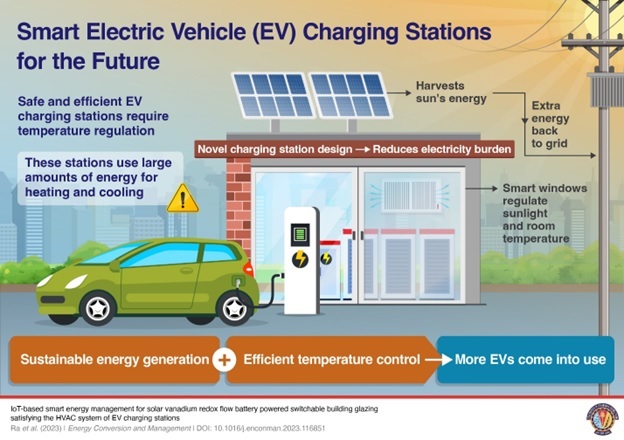Rapid urbanisation and industrialisation have led to significant growth in the transportation sector, making it a major contributor to global greenhouse gas emissions. In tropical countries like India, which are characterised by high temperatures, heavy reliance on coal, and rapid population growth, the impact of these emissions is further intensified. To combat this pressing issue and prevent global temperatures from exceeding the 1.5 °C target set by the Paris Agreement, it is crucial to widely adopt electric vehicles (EVs) whose batteries are powered by renewable energy sources.
However, the EV charging infrastructure in many parts of India is insufficient and falls short of expectations in this regard. A key issue with current EV charging stations is that their control rooms require heating, ventilation, and air conditioning (HVAC) systems to maintain an optimal temperature for proper functioning of the equipment and batteries. Unfortunately, these requirements add to electricity consumption and further exacerbate the energy burden. And all of this burden is borne by the coal-powered traditional electrical grid.
If India is to achieve its ambitious goal of having 30% of its vehicles be electric by 2030, the establishment of reliable, energy-efficient, and sustainably-powered charging infrastructure is of utmost importance
Recognising this need, Professor Ankur Bhattacharjee and PhD student Nawin Ra from the Department of Electrical and Electronics Engineering at BITS Pilani, India, and Dr. Aritra Ghosh from the University of Exeter, United Kingdom, have proposed an EV charging station building with smart switchable glazing windows.
“Maintaining the thermal comfort of the buildings requires HVAC systems, which have significant power consumption. Building windows that incorporate smart switchable glazing can play a great role in reducing this electrical consumption, thereby making the overall system energy efficient,” says Prof. Bhattacharjee.
The windows intelligently regulate the amount of sunlight entering the control room, creating a comfortable indoor environment without relying heavily on energy-consuming HVAC systems. To further enhance their sustainability and self-reliance, they’re powered by solar panels on the roof when sunlight is abundant enough. The findings of their research were published in the journal Energy Conversion and Management on 26th February 2023.
Additionally, in the proposed EV charging station, a vanadium redox flow battery (VRFB), instead of conventional batteries, is used to store energy generated during periods of peak solar energy production. VRFB batteries offer significant advantages over conventional battery storage technologies due to their very long cycle life (>20,000 cycles) and the ability to scale power and energy capacity.
The inclusion of solar panels and the VRFB battery as supplementary power sources to the electric grid enhances the resilience of the EV charging station, guaranteeing a continuous energy supply to meet the building's glazing load in any weather condition.
What’s more, to ensure that the station is energy-efficient in all weather conditions, the different components of the EV charging station—solar PV source, VRFB storage, and distribution grid—are connected to an intelligent central controller that uses smart energy management algorithms to work out the most optimal way to supply power and meet the building glazing load demand. Furthermore, when surplus solar energy is available, the system can even export the excess power back to the distribution grid.
To validate their system, the researchers tested its effectiveness in meeting the power demands of a 100-square-metre window in real-world conditions. These scenarios included sunny conditions, intermittent cloudy weather, prolonged periods of cloudiness, and low solar irradiance coupled with frequent grid outages. Under these varying conditions, the system not only consistently met the required power demand of 500 W, but it also intelligently prioritised suitable energy sources and managed energy flow based on the prevailing environmental conditions.
In sunny conditions, the photovoltaic cells supplied the necessary power for the windows, with any excess energy being stored in the battery and exported to the grid. In intermittent cloudy conditions, the battery complemented the photovoltaic cells to meet the building's power demands, while in prolonged cloudy weather, energy from the distribution grid and the battery were used to power the building. Remarkably, even in the worst-case scenario with limited solar availability and frequent grid outages, the glazing load power demands were met by this novel system.
The success of the validation tests is encouraging. “This system can also be applied to any large-scale building where traditional windows can be replaced by smart switchable windows,” says Prof. Bhattacharjee, speaking of potential future applications.
The importance of this solution becomes apparent when considering the findings of a NITI Aayog (National Institution for Transforming India) report that highlights the "humongous growth" in electricity demand for buildings driven by urbanisation and increased ownership of air conditioning units. Against this backdrop, the proposed system holds tremendous potential in effectively addressing the mounting electricity demand, fostering the adoption of EVs and making meaningful contributions towards the attainment of the United Nations' sustainable development goal (SDG 7) of ensuring access to affordable, reliable, sustainable, and modern energy, in India.


 An Institute of Eminence
An Institute of Eminence








